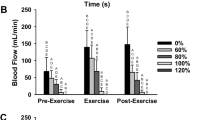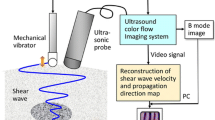Abstract
High risk of musculoskeletal diseases had been demonstrated in many people with a sedentary lifestyle. As microcirculation provides primary information on tissue health, this paper aims to compare the perfusion characteristics in neck/shoulder of individuals at different physical activity levels. High power laser Doppler flowmetry (LDF) system and averaging algorithm were used to obtain the microcirculatory characteristics. Thirty-two participants with different exercise habit were recruited, which were divided into sedentary group (n = 16) and exercise group (n = 16). The participants in both groups were matched in age, gender, and body mass index. Peripheral blood perfusion signals on the neck-shoulder region pre- and post- upper trapezius stretching were acquired using LDF with a noninvasive wide separation probe. A modified beat-to-beat algorithm was then applied for the analysis of the microcirculatory signals, including pulsatile and nonpulsatile components. The Mann–Whitney U test was used to compare the differences of perfusion characteristics between these two groups. The pulsatile component of LDF signals in the exercise group was greater than that of the sedentary counterparts after the upper trapezius stretching (P < 0.05). Furthermore, the index of perfusion pulsatility (ratio of pulsatile component to mean LDF signal) of the exercise group was significantly higher than that of the sedentary group (P < 0.01). This index could differentiate these two groups both at the baseline and post- stretching. Even with low exercise volume, exercise group with regular physical activity appear noticeably different in microcirculatory characteristics in this study. The subjects who exercised had higher values of microcirculatory pulsatility. These findings may encourage people to exercise more often based on the benefit in microcirculation even with small increases in physical activity volume.



Similar content being viewed by others
References
Bauman, A. E. (2004). Updating the evidence that physical activity is good for health: An epidemiological review 2000–2003. Journal of Science and Medicine in Sport, 7, 6–19.
Durstine, J. L., Gordon, B., Wang, Z., & Luo, X. (2013). Chronic disease and the link to physical activity. Journal of Sport and Health Science, 2, 3–11.
Duncker, D. J., & Bache, R. J. (2008). Regulation of coronary blood flow during exercise. Physiological Reviews, 88, 1009–1086.
Kvernmo, H. D., Stefanovska, A., Kirkebøen, K. A., Sterud, B., & Kvernebo, K. (1998). Enhanced endothelium-dependent vasodilatation in human skin vasculature induced by physical conditioning. European Journal of Applied Physiology and Occupational Physiology, 79, 30–36.
Endres, M., Gertz, K., Lindauer, U., Katchanov, J., Schultze, J., Schrock, H., et al. (2003). Mechanisms of stroke protection by physical activity. Annals of Neurology, 54, 582–590.
Jensen, B. R., Sjogaard, G., Bornmyr, S., Arborelius, M., & Jorgensen, K. (1995). Intramuscular laser-Doppler flowmetry in the supraspinatus muscle during isometric contractions. European Journal of Applied Physiology and Occupational Physiology, 71, 373–378.
Røe, C., & Knardahl, S. (2002). Muscle activity and blood flux during standardised data-terminal work. International Journal of Industrial Ergonomics, 30, 251–264.
Clough, G., Chipperfield, A., Byrne, C., De Mul, F., & Gush, R. (2009). Evaluation of a new high power, wide separation laser Doppler probe: Potential measurement of deeper tissue blood flow. Microvascular Research, 78, 155–161.
Chao, P. T., Jan, M. Y., Hsiu, H., Hsu, T. L., Wang, W. K., & Wang, Y. L. (2006). Evaluating microcirculation by pulsatile laser Doppler signal,”. Physics in Medicine & Biology, 51, 845–854.
Hsiu, H., Hsu, W. C., Chang, S. L., Hsu, C. L., Huang, S. M., & Lin, Y. Y. W. (2008). Microcirculatory effect of different skin contacting pressures around the blood pressure. Physiological Measurement, 29, 1421–1434.
Jan, M. Y., Hsiu, H., Hsu, T. L., Wang, Y. Y. L., & Wang, W. K. (2000). The importance of pulsatile microcirculation in relation to hypertension: Studying the relationship between abdominal aortic blood pressure and renal cortex flux. IEEE Engineering in Medicine and Biology, 19, 106–111.
Hsiu, H., Hsu, W. C., Wu, Y. F., Hsu, C. L., & Chen, C. Y. (2014). Differences in the skin-surface laser Doppler signals between polycystic ovary syndrome and normal subjects. Microcirculation, 21, 124–130.
Bau, J. G., Chia, T., Chung, Y. F., Chen, K. H., & Wu, S. K. (2013). A novel assessment of flexibility by microcirculatory signals. Sensors, 14, 478–491.
Haskell, W. L., Lee, I. M., Pate, R. R., Powell, K. E., Blair, S. N., Franklin, B. A., et al. (2007). Physical activity and public health. Medicine and Science in Sports and Exercise, 39, 1423–1434.
M. H. Lin and J. Y. Kuo, National Survey of Perceptions of Safety and Health in the Work Environment in Taiwan, Research Report 2013.
Feng, B., Liang, Q., Wang, Y., Andersen, L. L., & Szeto, G. (2014). Prevalence of work-related musculoskeletal symptoms of the neck and upper extremity among dentists in China. British Medical Journal Open, 4, e006451.
Collins, J. D., & O’sullivan, L. W. (2015). Musculoskeletal disorder prevalence and psychosocial risk exposures by age and gender in a cohort of office based employees in two academic institutions. International Journal of Industrial Ergonomics, 46, 85–97.
Hallman, D. M., Gupta, N., Mathiassen, S. E., & Holtermann, A. (2015). Association between objectively measured sitting time and neck–shoulder pain among blue-collar workers. International Archives of Occupational and Environmental Health, 88, 1031–1042.
Kisner, C., & Colby, L. A. (2007). Therapeutic exercise: Foundations and techniques. Philadelphia: F A Davis Company.
Page, P. (2012). Current concepts in muscle stretching for exercise and rehabilitation. International Journal of Sports Physical Therapy, 7, 109–119.
Alvarez, D. J., & Rockwell, P. G. (2002). Trigger points: Diagnosis and management. American Family Physician, 65, 653–660.
Wang, Y. Y. L., Hsu, T. L., Jan, M. Y., & Wang, W. K. (2010). Review: Theory and applications of the harmonic analysis of arterial pressure pulse waves. Journal of Medical and Biological Engineering, 30, 125–131.
Hsiu, H., Hsu, W. C., Hsu, C. L., Jan, M. Y., & Wang-Lin, Y. Y. (2009). Effects of acupuncture at the Hoku acupoint on the pulsatile laser Doppler signal at the heartbeat frequency. Lasers in Medical Science, 24, 553–560.
Pries, A., Secomb, T., & Gaehtgens, P. (1996). Biophysical aspects of blood flow in the microvasculature. Cardiovascular Research, 32, 654–667.
Bau, J. G., Chia, T., Chung, Y. F., Chen, K. H., & Wu, S. K. (2013). A novel assessment of flexibility by microcirculatory signals. Sensors (Basel), 14, 478–491.
Van Den Brande, P., Von Kemp, K., De Coninck, A., & Debing, E. (1997). Laser Doppler flux characteristics at the skin of the dorsum of the foot in young and in elderly healthy human subjects. Microvascular Research, 53, 156–162.
Strøm, V., Røe, C., & Knardahl, S. (2009). Work-induced pain, trapezius blood flux, and muscle activity in workers with chronic shoulder and neck pain. Pain, 144, 147–155.
Davies, J. I., & Struthers, A. D. (2003). Pulse wave analysis and pulse wave velocity: A critical review of their strengths and weaknesses. Journal of Hypertension, 21, 463–472.
Avolio, A. P., Van Bortel, L. M., Boutouyrie, P., Cockcroft, J. R., Mceniery, C. M., Protogerou, A. D., et al. (2009). Role of pulse pressure amplification in arterial hypertension experts’ opinion and review of the data. Hypertension, 54, 375–383.
Steppan, J., Barodka, V., Berkowitz, D. E., & Nyhan, D. (2011). Vascular stiffness and increased pulse pressure in the aging cardiovascular system. Cardiology Research and Practice, 2011, 1–8.
Lee, Y., & Hwang, K. (2002). Skin thickness of Korean adults. Surgical and Radiologic Anatomy, 24, 183–189.
Braverman, I. M. (1997). The cutaneous microcirculation: ultrastructure and microanatomical organization. Microcirculation, 4, 329–340.
Acknowledgement
We would like to acknowledge Dr. Fu-Chou Cheng, Stem Cell Center, Department of Medical Research, Taichung Veterans General Hospital, for writing instructions. We also thank Biostatistics Task Force of Taichung Veterans General Hospital for statistical analysis. This work was partially supported by National Science Council with Grant NSC 101-2221-E-241-001.
Author information
Authors and Affiliations
Corresponding author
Rights and permissions
About this article
Cite this article
Chia, T., Bau, JG., Li, YH. et al. Microcirculatory Characteristics in Neck/Shoulder of the Adults with Sedentary and Exercise Lifestyles. J. Med. Biol. Eng. 37, 912–919 (2017). https://doi.org/10.1007/s40846-017-0248-y
Received:
Accepted:
Published:
Issue Date:
DOI: https://doi.org/10.1007/s40846-017-0248-y




